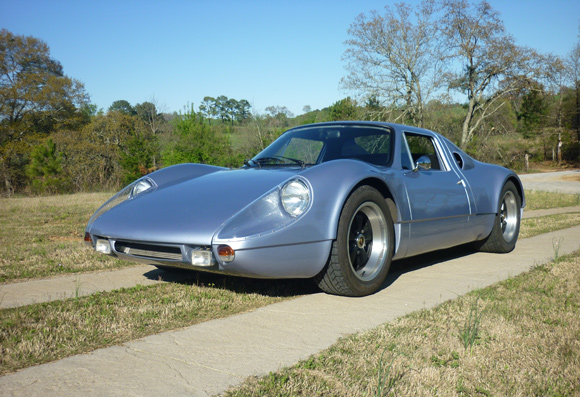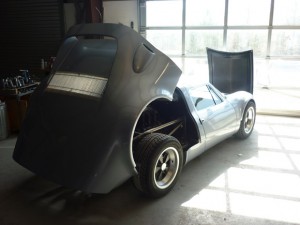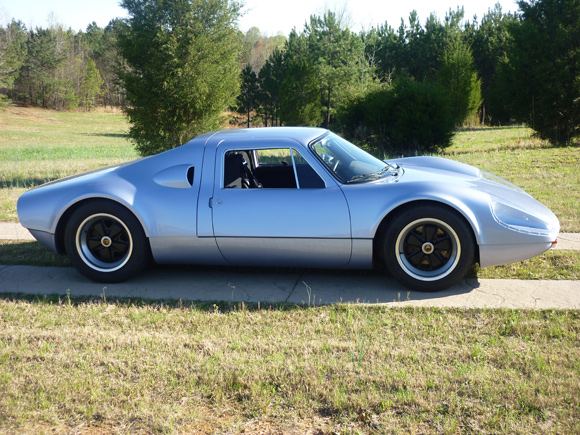 On a sunny day in Downtown Atlanta, the Georgia Institute of Technology held their annual car show. Open to students, alumni, and invitees, the campus parking lots housed an eclectic gathering of cars and motorcycles of all vintages. As I walked into the sunlight from the spectator parking structure my eyes caught sight of a sleek and streamlined beauty. I was aware that it would be at the show, and I had previously arranged to meet the owner of the car at this very spot, yet I was still caught off guard by its presence. This was what I had come for!
On a sunny day in Downtown Atlanta, the Georgia Institute of Technology held their annual car show. Open to students, alumni, and invitees, the campus parking lots housed an eclectic gathering of cars and motorcycles of all vintages. As I walked into the sunlight from the spectator parking structure my eyes caught sight of a sleek and streamlined beauty. I was aware that it would be at the show, and I had previously arranged to meet the owner of the car at this very spot, yet I was still caught off guard by its presence. This was what I had come for!
The hip-height racer brings to mind times gone by, and I couldn’t help but envision myself bombing down a long empty stretch of road, nestled among its sharp edged bodywork. The silver fiberglass body sitting in front of me is arguably the most beautiful shape ever put to paper by any designer under the Porsche label. Even though it arrived in 1963 and has not been produced in 46 years, it looks as though it could have rolled off an assembly line yesterday. With a low, narrow, sloping profile, this is a very modern design, well ahead of its time.
Making its first rennsport appearance at the 1964 Daytona Continental race, the 4 cylinder powered racers made a fairly inauspicious start to the season. Failing to finish at Sebring would not help the situation, though would set up the scenario for a perfect come-from-behind overall victory at the Targa Florio. High speed stability, light weight, and fuel efficiency helped propel the diminutive sports car through the Sicilian countryside to take the win. This, along with a class victory at the Nurburgring and at the 24 hours of Le Mans combined to solidify the 904’s reputation among Porsches as more than a pretty face.
Less than a year prior to the 904s spectacular series of victories, Ferdinand Alexander “Butzi” Porsche was putting pen to paper, designing the Carrera GTS. Naming the car his greatest success, Butzi has always loved the purity of the design, and admitted that, due to time crunches, very little changes were made from the clay model to the production vehicle. The 1964 FIA GT championship season was fast approaching, and the Carrera Abarth was having trouble continuing to hold the class under it’s thumb, necessitating a sleeker, more aerodynamic shape mated to the 1,966 cc powerplant. Butzi was required to perform in the design studio, and he certainly stood up to the challenge.
The man behind this spectacularly beautiful re-imagining of Porsche’s 904 is Chuck Beck. Renowned for his work in custom fabrication, both in racing applications and for OEs, Mr. Beck has made quite a name for himself in the vintage car replication business as well. The thing about Chuck’s work, though, is Chuck doesn’t simply replicate the cars to the letter, he uses the car as a base on which to improve while still maintaining its essence. In his words, “I tend to engineer for overkill.”
Opening the doors on this business nearly thirty years ago, he started by replicating Porsche’s excellent 550 Spyder. Using a fiberglass body and a VW Type 1 engine, he offered a vintage roadster experience at a fraction of the cost of a “real” one. In itself, the Beck “Spyder” sold over 2200 units, and while it has been out of production for a few years, Beck is working to get new spyders back on the road by the end of the year. Chuck then moved on to replicate the Lister sports racers of the 50s with entirely too much power, one of which was equipped with nearly 800 horsepower and could demolish a quarter mile in just over ten seconds. The third, and current, project is the one laid out before me, the Beck 904.
 Chuck realized the attraction of the 904’s shape, and combined with his history with Porsche powerplants, the project was a no-brainer. While the 904 was designed from the beginning with racing in mind, Beck used it in racing as an afterthought. Wanting to create an utterly quick street car was his aim. Not wanting to disrupt the visual curves of the 904, though still wishing to be able to comfortably drive the car, Chuck was forced to stretch the shape about 5 inches, all inside the wheelbase. These 5 inches provide a clear benefit, as someone over 5 feet tall can now drive the car without issues. Those of us over 6 feet tall will still have trouble, though with some select modifications, Chuck says it is feasible. Even if you look a bit foolish getting in and out of the thing, you forget all about it as soon as the engine turns to life.
Chuck realized the attraction of the 904’s shape, and combined with his history with Porsche powerplants, the project was a no-brainer. While the 904 was designed from the beginning with racing in mind, Beck used it in racing as an afterthought. Wanting to create an utterly quick street car was his aim. Not wanting to disrupt the visual curves of the 904, though still wishing to be able to comfortably drive the car, Chuck was forced to stretch the shape about 5 inches, all inside the wheelbase. These 5 inches provide a clear benefit, as someone over 5 feet tall can now drive the car without issues. Those of us over 6 feet tall will still have trouble, though with some select modifications, Chuck says it is feasible. Even if you look a bit foolish getting in and out of the thing, you forget all about it as soon as the engine turns to life.
The 904 has a presence at car shows, attracting a large group of people within seconds. Many show-goers asking “what is that?” and others more apprised of racing history asking for specifics covering powerplant, provenance, and manufacture. This particular model is owned by Mr. Beck, is an example of a “base” model. Powered by a completely stock 993 generation 3.6 liter flat 6, the car produces power as Porsche intended with a maximum output of 272 horsepower. That may not sound like much, however instead of the 993’s 3000+ pound curb weight, the engine is only asked to propel 1700 pounds in the 904. Driven through a stock 915 gearbox set up for mid-engine power, the car is very docile around town.
Its unassuming nature at normal driving speeds is equally as awesome as its monster-like nature above 4500 RPM. Almost as if it were awakened from a winter slumber, the 2000 RPM range from 4500 to the relatively low 6500 RPM redline are the field in which this bear plays regularly. Don’t be afraid to play with the bear from time to time, but don’t be surprised when it swipes your head off in one quick motion.
Not a car to be taken lightly, the Beck 904 is very visceral, yet surprisingly tame. The Beck-designed tub and suspension is quite calm and collected, and combined with the mid-engine layout, conspires to allow extremely high cornering forces and much higher corner entry speeds than you would expect. While I was expecting cornering on par with even the most advanced sport cars due to its light weight, what I did not expect was the sheer insanity of its straight line acceleration. A stock 993 Carrera 2 will get to 60 miles per hour in a fairly respectable 5.3 seconds, using the same engine but asked to push such a light weight machine, if driven correctly, the base Beck 904 can sprint from zero to sixty in about three and a half seconds. This type of acceleration is just insane to experience. I felt as though the back of my head had dropped anchor at the start line, from the moment the accelerator was depressed to the time we hit 150 miles per hour my head was buried in the lightly padded seat back.
The other very startling revelation was the fact that, with so little mass to accelerate, it also didn’t take much to bring that mass back to a full stop. With my head buried in the seat at extralegal speeds, one tap on the middle pedal made me feel as though my brain may extricate itself from my body through my eye sockets. Chuck claims that jabbing the brakes above 160 is unsettling to the rear end, but otherwise it is quite predictable under braking and I can attest that it stops in very short distances.
 So, now that you are sufficiently entranced by its beauty, and are well apprised of its performance, you want to know what it will take to get one. Well, get in line. Beck Development currently is made up of Chuck and his son, and they assemble about 10 cars per year. Nearly every car is custom tailored to the owner’s specifications for a reasonable fee. However, if you want a “base” model with 8 and 9 inch Fuch reproduction wheels, a 915 gearbox and a 3.6 liter, it will run you around 65,000 dollars. Considering that the same 65,000 dollars won’t even get you a new domestic full-sized pickup truck these days, it is such a blatantly obvious good deal that you should be breaking your jar labeled “Kid’s college fund” open with a ball-peen hammer as you read this.
So, now that you are sufficiently entranced by its beauty, and are well apprised of its performance, you want to know what it will take to get one. Well, get in line. Beck Development currently is made up of Chuck and his son, and they assemble about 10 cars per year. Nearly every car is custom tailored to the owner’s specifications for a reasonable fee. However, if you want a “base” model with 8 and 9 inch Fuch reproduction wheels, a 915 gearbox and a 3.6 liter, it will run you around 65,000 dollars. Considering that the same 65,000 dollars won’t even get you a new domestic full-sized pickup truck these days, it is such a blatantly obvious good deal that you should be breaking your jar labeled “Kid’s college fund” open with a ball-peen hammer as you read this.
Is 272 a small number in your eyes? Are you looking for a car with a more favorable horsepower to weight ratio than 1:6.25? Do you spend your days bouncing off the walls of padded rooms? Chuck is currently developing watercooled solutions, as he plans to install a 997 GT3 engine in his personal car. He has also been known to build turbo assisted cars with everything from a 930 engine to a 962 race engine. Ranging from more-than-sufficient to crazy-enough-to-require-a-medically-induced-coma levels of power, Beck Development can put together a 904 anywhere on the spectrum to fit your needs.
Photos: 9 Magazine / Brad Brownell




